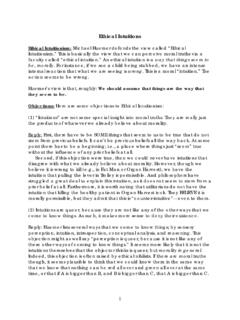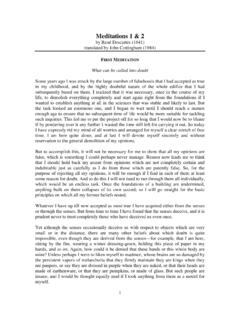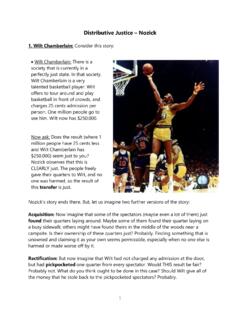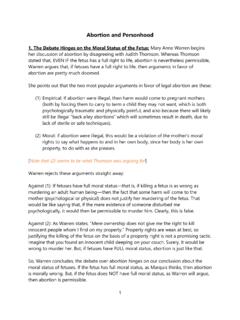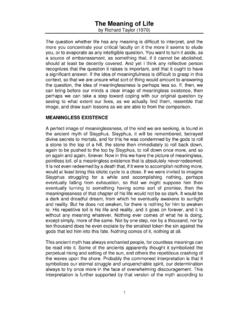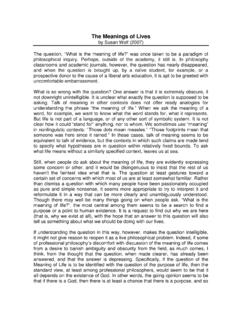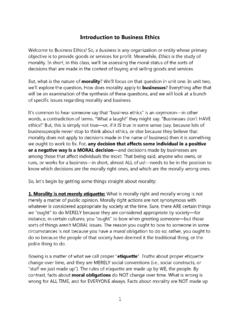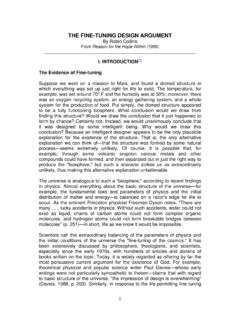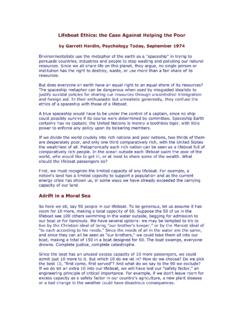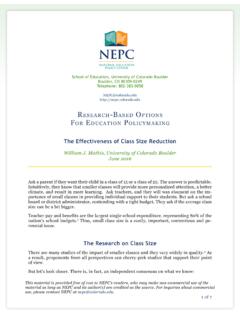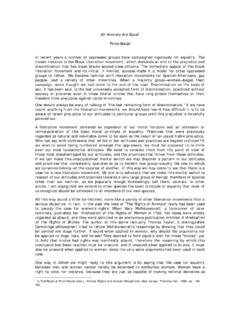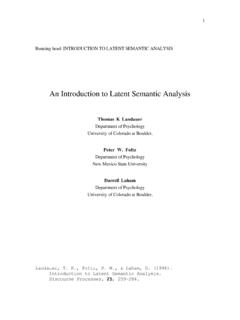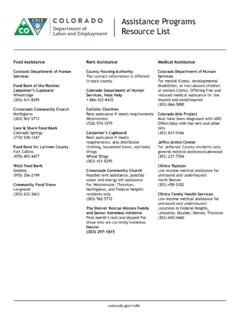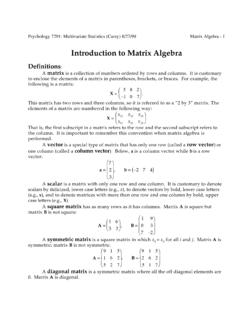Transcription of Distributive Justice Nozick - University of Colorado Boulder
1 Distributive Justice Nozick 1. Wilt Chamberlain: Consider this story: Wilt Chamberlain: There is a society that is currently in a perfectly just state. In that society, Wilt Chamberlain is a very talented basketball player. Wilt offers to tour around and play basketball in front of crowds, and charges 25 cents admission per person. One million people go to see him. Wilt now has $250,000. Now ask: Does the result (where 1. million people have 25 cents less and Wilt Chamberlain has $250,000) seem just to you? Nozick observes that this is CLEARLY just. The people freely gave their quarters to Wilt, and no one was harmed, so the result of this transfer is just. Nozick 's story ends there. But, let us imagine two further versions of the story: Acquisition: Now imagine that some of the spectators (maybe even a lot of them) just found their quarters laying around. Maybe some of them found their quarter laying on a busy sidewalk; others might have found theirs in the middle of the woods near a campsite.
2 Is their ownership of these quarters just? Probably. Finding something that is unowned and claiming it as your own seems permissible, especially when no one else is harmed or made worse off by it. Rectification: But now imagine that Wilt had not charged any admission at the door, but had pickpocketed one quarter from every spectator. Would THIS result be fair? Probably not. What do you think ought to be done in this case? Should Wilt give all of the money that he stole back to the pickpocketed spectators? Probably. 1. 2. Entitlement Theory: Our verdicts in the Wilt Chamberlain case align themselves with Nozick 's proposed principles of Justice . Robert Nozick states that a distribution of wealth is just, so long as it follows these 3 rules: 1. Justice of acquisition: If you acquired something justly, then it is just to own it (for example, we may justly acquire something that is unowned if doing so does not leave others worse off). In the Wilt Chamberlain example, the spectators who found their quarters acquired them justly (they were unowned; no one is worse off).
3 Note: As an example of finding something unowned and claiming it for one's self which is NOT just, we might imagine a group of settlers arriving at their destination, and one person finding and claiming the unowned water source as their own. This sort of acquisition is NOT just because it leaves everyone else worse off (for instance, because the other settlers will all now die of thirst). 2. Justice of transfer: If someone who justly owns something freely transfers that property to another, then it is just for that other person to own it (provided that it does not leave others worse off). In the example above, the spectators may justly transfer their quarters to Wilt if they want to (no one is worse off). 3. Rectification of injustices: If someone UNjustly owns something (by unjust acquisition or transfer), then the situation ought to be rectified ( , by restoring the property to its rightful owner). If Wilt pickpockets his audience, he is obligated to rectify the situation ( , return the money).
4 3. Historical vs. End-State Principles: Nozick makes a distinction between principles of Justice which are historical , and those that are NON-historical : Historical Principles of Justice : Principles for which, if we were to examine a distribution of wealth, we cannot determine whether it is just or unjust unless we know some of the HISTORICAL DETAILS about how this distribution CAME. ABOUT. Non-Historical Principles of Justice : Principles for which, in order to determine whether or not a distribution is just or unjust, we ONLY need to look at the distribution itself, and we do NOT need to know any of the historical details regarding how this distribution came about. 2. Note: It might help to think of non-historical views as time-slice views. They are ones where we need only look at a single snapshot of a time (a single moment, or slice of time) in order to determine whether or not it is just. Nozick calls these non- historical views end-state views , ones which are only concerned with the RESULTING distribution, or the ENDS, rather than the MEANS by which it is brought about.
5 Nozick 's Principles are Historical: Right away, we see that Nozick 's notion of the Justice of ownership or possession is HISTORICAL. For instance, if we were to merely consider the distribution where Wilt Chamberlain has $250,000, and everyone else has a lot less, we cannot know whether the distribution is just or unjust unless we know how that distribution was BROUGHT ABOUT. In Nozick 's version of the story (where the spectators freely agree to pay a quarter to see Wilt), the end result is just (because Wilt received the money by a just transfer). On the other hand, in my version of the story where Wilt PICKPOCKETS the spectators, the end result is NOT just (because Wilt did NOT receive the money by a just transfer). The Utilitarian Principles are Non-Historical: Contrast Nozick 's view with utilitarianism, which says that a situation is just if it is the one with the maximum amount of happiness (no matter how that maximum was achieved remember the Organ Harvest example, where the end result of four patients being alive and one being dead is just, REGARDLESS of the fact that the doctor had to murder the one healthy patient to save the other four).
6 Rawls's Principles are Non-Historical: Or, consider Rawls's theory, which says (according to Nozick ) that a situation is just so long as it is one where the worst off are as well off as possible (with no need to look at how this distribution is BROUGHT ABOUT). 4. Patterned vs. Non-Patterned Principles: Nozick makes another distinction as well, between patterned and non-patterned principles of Justice . Patterned Principles of Justice : Principles which dictate that we distribute goods according to some specific property, formula, or pattern. For instance, we might think it is just to distribute goods according to moral merit, need, usefulness to society, IQ, hair color, etc. Note: Patterned principles can be historical ( , moral merit) or non-historical ( , IQ). Non-Patterned Principles of Justice : Principles which dictate that we distribute goods in a way that does not follow some pattern. 3. Utilitarian Principles are Patterned: Utilitarian principles are patterned, since they suggest that we should distribute goods according to whatever maximizes the total amount of happiness.
7 Rawls's Principles are Patterned: Similarly, Nozick suggests that Rawls's principles are also patterned, since Rawls proposes that we should distribute goods according to whatever maximizes the status of the worst off. Nozick 's Principles are Non-Patterned: Nozick 's principles propose that the acquisition and transfer of goods is always just so long as we do so freely (and provided that we do not make others worse off) and a system which allows this sort of freedom of giving, purchasing, trading, and so on will not result in any particular identifiable pattern of distribution. 5. Re-Distribution of Wealth is Unjust: Nozick criticizes patterned theories ( , Rawls), because he believes they will all run up against one basic problem. Consider the Wilt Chamberlain scenario again. The resulting distribution is just because it is the result of a just transfer. After all, the people FREELY gave their money to Wilt in order to watch him. However, even if in the beginning of that story, the distribution exemplified the just PATTERN, at the END of the story, the pattern has now been upset.
8 Consider Rawls's view, for instance. Once Wilt has $250,000, he is now no longer equal with everyone else. Has this inequality benefited EVERYONE (including the people who did not even attend his tour? Certainly not. Rawls, therefore, must say that this end-result is unjust. The transfer of quarters to Wilt has upset the preferred pattern , the new pattern is one that people behind the veil of ignorance would NOT choose. In short, a great inequality is brought about and the worst off are NOT made better so the distribution is unjust. According to Nozick , since the new distribution is unjust according to Rawls, Rawls would suggest that we must RESTORE Justice . This means that we must restore the situation to something like its original state in order to restore Justice . But, how would we do this? Should we take Wilt's money away and re-distribute it? It seems like that would be wrong. The point: Nozick 's point with this example is that any patterned principle of distribution will be nearly impossible to maintain without violating our liberties (because people will be constantly freely giving/trading their goods to create inequalities, which is surely permissible).)
9 Therefore, in order to maintain any patterned principle, we would need to either: 4. (a) Make it very HARD to upset the pattern; , by heavily taxing or regulating the sorts of activities that upset the pattern. (b) Constantly intervene in order to adjust the system; , by continually re- distributing goods. In short, Rawls's view calls for heavy regulation, re- Distributive taxation, or both (and both of these practices, according to Nozick , violate our liberty). Taxation is Analogous to Forced Labor: But, why does Nozick think that taxation ( , re- distribution) is unjust? To understand Nozick 's answer to this question, consider our current practice of taxing people more when they earn more. Peggy, the Materialist: Peggy likes to spend her extra time working a little more than she would need to in order to feed, clothe, and house herself she works the extra hours so that she can buy some extra luxury goods and services ( , a giant flat-screen tv, a nice car, an awesome laptop and cell phone, concert tickets, etc.)
10 Sue, the Naturalist: Sue likes to work the bare minimum number of hours that she needs to in order to support herself. She spends her extra time hiking, swimming, looking at sunsets, and playing hackey sack. Peggy has more material wealth/more goods than other people but her acquisition has not made anyone else better off. Should we take some of these goods away from her in order to try to restore the just Rawlsian pattern? To some extent, this is what we ALREADY do via taxation. Peggy will get taxed more than Sue. Sue on the other hand, will not get taxed at all (let's assume that she earns too little to be considered taxable by the government; , she is below the poverty line). But, now imagine that Sue DOES reap the benefits of the taxation of others ( , by driving on roads built with tax dollars, and attending public schools, and being benefited by police and military protection, etc.). Is it fair that, just because Peggy enjoys the sorts of things that cost money (and therefore has to work longer hours in order to afford them), she is taxed a lot more than Sue (who says the best things in life are free )?
